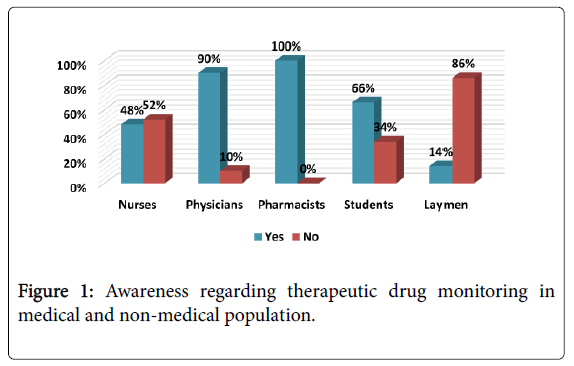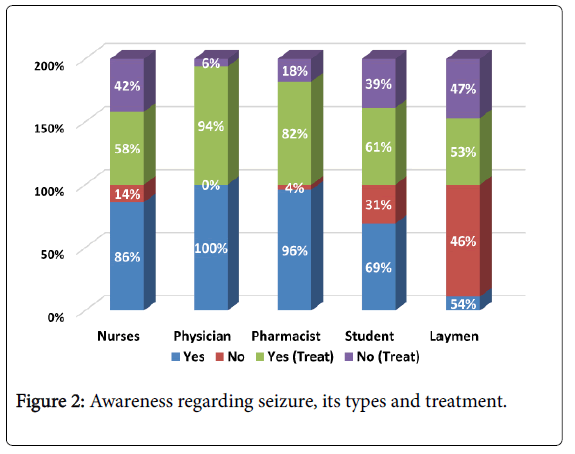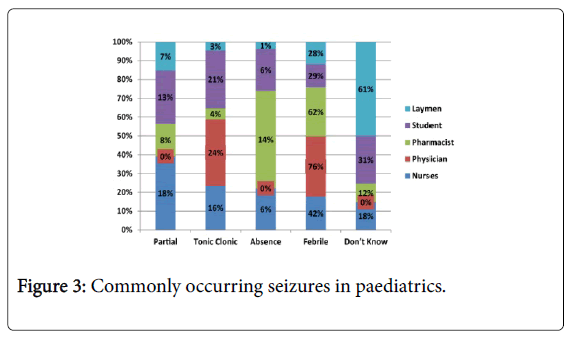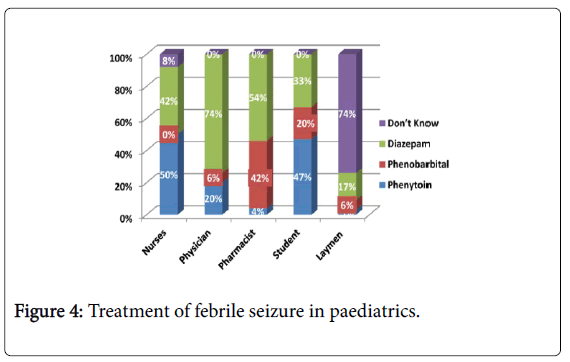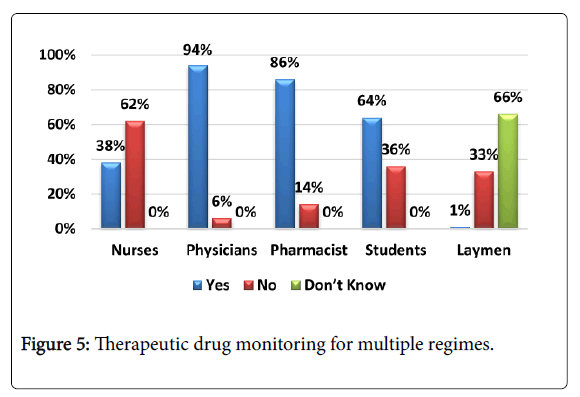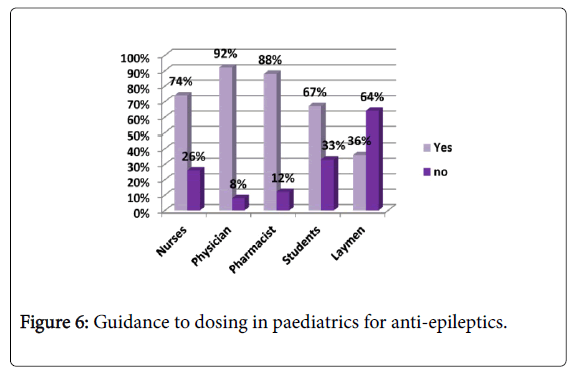Research Article Open Access
Practice of Therapeutic Drug Monitoring with Multiple Regimes in Paediatrics
Sana Sarfaraz*, Aliya Jamil, Maryam Yousuf, Ayesha Nisar, Mariam Humayoun and Maria TirmiziFaculty of Pharmacy, Jinnah University for Women, Karachi, Pakistan
- Corresponding Author:
- Sana Sarfaraz
Faculty of Pharmacy, Jinnah University for Women, Karachi, Pakistan
Tel: +922136620857 E-mail: sana.sarfraz@live.com
Received Date: October 17, 2016; Accepted Date: November 15, 2016; Published Date: November 24, 2016
Citation: Sarfaraz S, Jamil A, Yousuf M, Nisar A, Humayoun M, et al. (2016) Practice of Therapeutic Drug Monitoring with Multiple Regimes in Paediatrics. J Pharmacokinet Exp Ther 1:105.
Copyright: © 2016 Sarfaraz S, et al. This is an open-access article distributed under the terms of the Creative Commons Attribution License, which permits unrestricted use, distribution, and reproduction in any medium, provided the original author and source are credited.
Visit for more related articles at Journal of Pharmacokinetics & Experimental Therapeutics
Abstract
Background: Therapeutic Drug Monitoring (TDM) is a clinical practice, being done especially for monitoring drugs with narrow therapeutic index.
Objective: The aim of our study is to evaluate whether TDM is being practiced for anti-epileptic in paediatrics especially when a patient has undergone treatment with multiple regimes and also to check the awareness among laymen regarding dosing and quantity of medications and TDM.
Methodology: It is a descriptive cross sectional survey based study consisting of N=350 individuals out of which N=50 each doctors, nurses, Pharmacists=100 medical students and laymen each. This survey was conducted from different hospitals. The questionnaire contained 11 questions. The answers were recorded as open and closeended.
Results and discussion: Our study showed that 74% medical population whereas only 14% of laymen population is aware about TDM. The awareness regarding seizure and its type is 84% in medical population and 11% in laymen population. According to medical professional, Febrile (47.60%) reported to be the most common type of seizures in paediatrics, Tonic clonic is 17.20% and Absence (6.40%) is reported to be least common in paediatrics, where as 60% of laymen population is not aware of any of them. 18.5% physician, 16.5% medical students, 13.5% pharmacists and 10.5% nurses suggest Diazepam to be drug of choice in febrile seizures where as 17% laymen also consider the same drug of choice. 86% pharmacist, 87% physicians and only 38% nurses agreed that TDM was followed during multiple therapy. 36% laymen were satisfied with dosage instructions regarding antiepileptics and 32% laymen usually divided tablet into 2 parts for giving dose to paediatrics.
Conclusion: From our result we came to conclude that TDM should be practiced while giving multiple regimens to paediatrics. Awareness programs regarding quantity and dosage of medications should be done in laymen population.
Keywords
Multiple regimes; Paediatrics; Seizures; Therapeutic Drug Monitoring (TDM)
Introduction
Epilepsies are a type of brain disorders that can vary in severity from being benign, disabling, to severe life threatening. Epilepsy can cause strange sensations, emotions and behaviour or sometimes convulsions, muscle spasms, and loss of consciousness due to changes in normal pattern of neuronal activity [1]. Understanding of epilepsy has changed dramatically in recent times due to major technological and scientific advances. As a result, there has been a recent change made for seizure terminology.
Based on the type of behaviour and brain activity, seizures are divided into two broad categories: Generalized and partial (also called local or focal). Focal (partial) seizures are prevalent in 60% of people with epilepsy [2]. These seizures can often be subtle or unusual. Seizure activity starts in one area of the brain and may spread to other regions of the brain [3]. Types of focal (partial) seizures involve: Focal seizureawareness retained (formerly simple partial seizures), Focal dyscognitive seizures-awareness altered (formerly complex partial seizures) and Focal seizures evolving to a bilateral convulsive seizure (formerly generalized tonic clonic). Generalized seizures are the result of abnormal activity in both hemispheres of the brain simultaneously. Because of this, consciousness is lost at the onset of the seizure.
Types of generalized seizures include: Absence (petit mal), tonic clonic and myoclonic [4]. A low percentage of all children have a seizure when younger than 15 years, half of which are febrile seizures (seizure brought on by a fever). One of every 100 children has epilepsyrecurring seizures. Febrile seizures are the most common type of seizure seen in children. Neonatal seizures occur within 28 days of birth. Most occur soon after the child is born. They may be due to a large variety of conditions. Status epilepticus is either a seizure lasting longer than 30 minutes or repeated seizures without a return to normal in between them. It is most common in children younger than 2 years, and most of these children have generalized tonic-clonic seizures [5].
Treatment of children with seizures is different than treatment for adults [6]. Most children with first-time seizures will not be placed on medications, unless a specific cause is diagnosed. The goal of treatment is restoration to near normal life with complete seizure control using a single Anti-Epileptic Drug (AED). Monotherapy is recommended because of fewer adverse drug effects, absence of drug-drug interactions, better compliance, and lower cost compared to therapy with multiple AEDs [7-10].
Anti-Epileptic Drugs (AEDs) have been among the most common medications for which Therapeutic Drug Monitoring (TDM) is performed especially in paediatrics. For these drugs attention needs to be paid to issues such as the timing of the measurements in relation to drug intake, the presence or absence of steady-state conditions, the presence in plasma of active metabolites and possible nonlinear pharmacokinetics of particular agents e.g., phenytoin.
The TDM means using blood levels to individualize epilepsy treatment to get the best seizure control with the least side effects for each individual. Managing epilepsy generally involves looking at the type of seizures a child is experiencing and what effects are being produced due to it. The TDM in therapy of epilepsy is necessary for the reason that the pharmacokinetics of several AEDs are age-dependent, and dosages are more variable among patients also the adverse effects of AEDs and the pattern of exacerbation of certain seizures by AEDs may be different in Paediatrics. Therefore, a careful and detailed assessment is required to select the most appropriate AEDs for paediatrics [11-13]. TDM of the older antiepileptic drugs phenobarbitone and phenytoin began to come into use in the late 1960s-1980s, further 17 drugs have been introduced since 1989 some of which are also effective for managing other neurological disorders.
The clinical trials of investigational AEDs are undertaken primarily to establish safety, ascertain pharmacokinetics, and dosage range, their drug–drug interactions since Several AEDs, namely carbamazepine, phenobarbital, and phenytoin, are well-known 'inducers' (stimulators) of 'drug-metabolizing' enzymes in the liver and other organs [14]. The fact that traditional AEDs in general have narrow therapeutic ranges and significant inter-individual variability in their pharmacokinetics (absorption, distribution, metabolism, and excretion) conducting TDM is important [15].
Our study is based on evaluating awareness regarding TDM in health care professionals as well as laymen, to evaluate knowledge regarding common type of seizures, its treatment and counselling regarding use of anti-epileptics in paediatric population. It is a simple initial level study to evaluate awareness regarding TDM.
Materials and Methodology
A descriptive cross sectional based study about Therapeutic dose monitoring of antiepileptic in paediatrics was carried out. The data was collected from different private and government hospitals, universities and from different locations in Karachi consisting of N=350 medical Professionals including nurses, physicians and pharmacist 50 each and students and laymen 100 each. The questionnaire for this survey contained 11 questions regarding the awareness of practicing TDM in antiepileptic in paediatrics. The collected data was then studied and evaluated. The study was carried out from January 2016-April 2016.
Inclusion Criteria
• Health care professionals who are in practice.
• Medical students who have passed their 4 year.
• Laymen were included who had children who had suffered from seizures or any child family member/relative who had seizures.
Consent was taken from all the individuals involved in the study prior to questioning.
Results and Discussion
TDM is very essential for proper therapeutic effect of drug. If a drug has narrow therapeutic index and it’s not monitored properly can lead to severe adverse effects and worsen the condition of the patient.
Figure 1 represents awareness regarding TDM among professionals and laymen. Our results show that 90% of physicians were well informed about the term, whereas awareness was only 14% among laymen regarding the term. TDM refers to measuring of concentration of drug in the blood. It is based on Pharmacokinetic as well as Pharmacodynamics monitoring [16].
Numerous variables can influence the interpretation of drug concentration data which include time, route and dose of drug given, time of blood sampling, handling and storage conditions, precision and accuracy of the analytical method, validity of pharmacokinetic models and assumptions, co-medications and clinical status of the patient (i.e., disease, renal/hepatic status, biologic tolerance to drug therapy, etc. [17]. Monitoring of plasma or serum concentrations of the older antiepileptic drugs phenobarbitone and phenytoin began to come into use in the late 1960s as a research procedure [18].
Figure 2 shows awareness regarding seizures, its types and its treatment. Our results show that 54% of laymen had awareness regarding seizures and its types while 47% had no idea about the treatment plan with respect to the type of seizure. 86% nurses, 69% students had knowledge regarding seizures, its type and treatment.
According to literature survey misinformation and misperceptions regarding epilepsy have a long history and are still prevalent throughout society. And actions needed to improve public awareness and knowledge include informing journalists as well as writers and producers in the entertainment industry; engaging people with epilepsy and their families in public awareness efforts [19].
Figure 3 represents knowledge about commonly occurring seizures in paediatrics i.e., febrile seizures. 12% pharmacist, 18% nurses, 31% student and 61% laymen did not have any knowledge regarding commonly occurring seizures in pediatrics.76% physicians considered febrile seizures more dominant in paediatric population.
Literature emphasizes that informing parents by providing adequate knowledge and awareness regarding fever and seizure and related easy prevention is an important step to decrease concerns and anxiety in them. Followed by observing the first febrile seizure, many parents are afraid and every time their children have fever, it can be disturbing and problematic for them; however, contrary to parents thinking, this disease in children is benign and is easily preventable, and rarely causes cerebral injuries [20].
According to literature review drug of choice widely regarded for febrile seizures was found to be Phenobarbital albeit the results showed that Diazepam is followed in common practice among 74% of physicians because of the ease in availability and safety for patient. 50% nurses opted for Phenytoin whereas 42% chose Diazepam as drug of choice. Only 6% of physicians had familiarity with the drug of choice coinciding with the literature as shown in Figure 4 [21].
Figure 5 shows practice of therapeutic drug monitoring in case of multiple regime. According to our results a controversy came to light at this point which shows that 94% of physicians consider TDM in case of multiple regimes but 62% nurses said it was not considered and 66% laymen had no awareness for TDM in multiple regimes. Indications for the measurement of serum anticonvulsant concentrations include poor seizure control, toxicity, suspended gross noncompliance, status epileptic us and the elapse of 2-4 weeks after the initiation of therapy [22].
Figure 6 represents satisfaction regarding proper guidance of dosing in paediatrics for anti-epileptics. Our results showed that only 36% laymen were satisfied with dosage instructions regarding antiepileptics. While 74% nurses, 92% physicians and 88% pharmacist notified that the patients are completely guided regarding dosage of anti-epileptics. 64% laymen were dissatisfied and usually divided tablets into two/four parts for giving dose to paediatrics. Although, the approach to paediatric drug dosing needs to be based on the physiological characteristics of the child and the pharmacokinetic parameters of the drug. Modification of a dosage based on absorption, depends on the route of absorption, the physico chemical properties of the drug and the age of the child as revealed by literature studies [23].
Table 1 evaluates that 46% physicians recommend giving part dose to paediatrics by dividing the tablet into two. Whereas 84% pharmacists recommend dissolving the tablet in water to give a part dose and 32% laymen usually divided tablets into two parts 16% into four parts and 7% in 6 parts for giving dose to paediatrics. 86% physicians claim about patient stability after treatment whereas only 28% laymen agreed that their child got stabilized after therapy. Paediatric patients encompass a variety of ages, weights, and body surface areas which makes patient-specific dosing calculations a necessity. Also, a suitable formulation is not always available for a paediatrics patient, as in dissolving a tablet in suitable solvent rather than breaking it into parts. Therefore, it is important that the pharmacist provide proper patient education to both the patient and caregiver regarding strategies to aid with administration [24-25].
| Nurses (50) | Pharmacist (50) | Students (100) | Physicians (50) | Laymen (100) | ||
|---|---|---|---|---|---|---|
| Giving part dose to paediatrics (Tab) | Divide into 2 | 34% | 12% | 33% | 46% | 32% |
| Divide into 4 | 38% | 4% | 24% | - | 16% | |
| Divide into 6 | 26% | - | 11% | - | 7% | |
| Dissolve in water | 2% | 84% | 21% | 54% | 22% | |
| Don’t Know | - | - | 11% | - | 23% | |
| Patient stability | Yes | 62% | 82% | 54% | 86% | 28% |
| No | 18% | 14% | 46% | 14% | 31% | |
| Don’t Know | 20% | 4% | - | - | 41% |
Table 1: How dose given and its effect on paediatrics population.
Table 2 shows that there is highly significant difference in knowledge about TDM among different health care professionals as well as laymen. The table shows there is no difference in knowledge if physician and pharmacist regarding TDM, however nurses have highly significantly reduced knowledge as compared to physicians and pharmacist. Knowledge of laymen is highly significantly less as compared to Physicians, Pharmacist, Nurses and Medical students, Whereas the knowledge and awareness of TDM in medical students is highly significantly less as compared to Physicians and Pharmacist but was significantly more as compared to nurses and highly significantly more as compared to laymen.
| Awareness regarding TDM | Population | P values |
| Nurses | Pharmacist *** | |
| Physician*** | ||
| Medical Students* | ||
| Laymen*** | ||
| Pharmacist | Nurses*** | |
| Physician IS | ||
| Laymen*** | ||
| Medical students*** | ||
| Physicians | Pharmacist IS | |
| Nurses*** | ||
| Medical students*** | ||
| Laymen*** | ||
| Medical Students | Physician*** | |
| Pharmacist *** | ||
| Nurses*** | ||
| Laymen*** | ||
| Laymen | Physician*** | |
| Pharmacist*** | ||
| Nurses*** | ||
| Medical Student*** |
Table 2: Comparison among different population regarding awareness of TDM.
SPSS Version 20 was used for evaluating the above results. One way Anova was applied. Post hoc turkey’s test was done and P value:
p<0.05 was considered significant;
P<0.01 as moderately significant;
p<0.001 as highly significant.
Conclusion
Our study results revealed that therapeutic drug monitoring of antiepileptics in paediatrics is very essential and awareness must be established regarding therapeutic drug monitoring in case of multiple regimes of anti-epileptics especially in other health care professionals and parents/relatives of children suffering from seizures. Besides this methods should be adopted to minimize the common practice of dividing tablets into part dose for paediatrics.
References
- National Institute of Neurological Disorders and Stroke (2016) The Epilepsies and Seizures: Hope through Research.
- Daroff RB, Fenichel GM, Jankovic J, Mazziotta JC (2012) Bradley's neurology in clinical practice (6thedn.) Philadelphia, PA, Elsevier Saunders, United States.
- Fisher R, Van EBW, Blume W, Elger C, Genton P, et al. (2005) Epileptic seizures and epilepsy: definitions proposed by the International League Against Epilepsy (ILAE) and the International Bureau for Epilepsy (IBE). Epilepsia46: 470-472.
- Epilepsy Action Australia (2016) Understanding Epilepsy. Seizure Types and Classification.
- http://www.emedicinehealth.com/seizures_in_children/article_em.htm
- NICE Clinical Guidelines (2012)The Epilepsies: The Diagnosis and Management of the Epilepsies in Adults and Children in Primary and Secondary Care: Pharmacological Update of Clinical Guideline 20.
- Benbadis SR, Tatum WO, Gieron M (2003) Idiopathic generalized epilepsy and choice of antiepileptic drugs. Neurology 61: 793-1795.
- Genton P, Gelisse P, Thomas P, Dravet C (2000)Do carbamazepine and phenytoin aggravate juvenile myoclonic epilepsy?. Neurology 55: 1106-1109.
- Osorio I, Reed RC, Peltzer JN (2000) Refractory idiopathic absence status epilepticus: A probable paradoxical effect of phenytoin and carbamazepine. Epilepsia 41:887-894.
- Thomas P, Valton L, Genton P (2006)Absence and myoclonic status epilepticus precipitated by antiepileptic drugs in idiopathic generalized epilepsy. Brain 129: 1281-1292.
- Matthew DK (2010) Therapeutic Drug Monitoring of the Newer Anti-Epilepsy Medications. Pharmaceutical (Basel) 3: 1909-1935.
- Bourgeois BF (1995) Antiepileptic Drugs in Pediatric Practice.Epilepsia 36: S34-S45.
- Schuetz EG (2001)Induction of cytochromes P450. CurrDrugMetab2:139-147.
- Fröscher W, Eichelbaum M, Gugler R, Hildebrand G, Penin H (1981)A prospective randomized trial on the effect of monitoring plasma anticonvulsant levels in epilepsy. J Neurol224:193-201.
- Anuzzi G, Cian P, Fattore C, Gatti G, Bartoli A, et al. (2000)A multicenter randomized controlled trial on the clinical impact of therapeutic drug monitoring in patients with newly diagnosed epilepsy.Epilepsia 41:222-230.
- Marshall W, Lapsley M, Day A (2016) Clinical Chemistry(8thedn.) Mosby Elsevier, Edinburgh, London, United Kingdom.
- Burton ME, Shaw LM, Schentag JJ, Evans WE (2005)Applied Pharmacokinetics and Pharmacodynamics (4thedn. )Lippincott Williams & Wilkins, Baltimore, Philadelphia, United States.
- Eadie MJ (1998)Therapeutic drug monitoring-antiepileptic drugs. Br J ClinPharmacol 46: 185-193.
- England MJ, Liverman CT, Schultz AM, Strawbridge LM (2012)Epilepsy across the spectrum: Promoting health and understanding. A summary of the Institute of Medicine report. EpilepsyBehav 25: 266-276.
- Hirtz DG, Lee YJ, Ellenberg JH (1986) Survey on the management of febrile seizures. Am J Dis Child140: 909-914.
- Choonara IA, Rane A (1990) Therapeutic drug monitoring of anticonvulsants. ClinPharmacokinet 18: 318-328.
- Bartelink IH, Rademaker CM, Schobben AF, van den Anker JN (2006) Guidelines on paediatrics dosing on the basis of developmental physiology and pharmacokinetic considerations. ClinPharmacokinet 45: 1077-1097.
- Stucky ER (2003) Prevention of medication errors in the paediatric inpatient setting. Pediatrics 112:431-436.
- Benavides S, Huynh D, Morgan J, Briars L (2011) Approach to the paediatric prescription in a community pharmacy. J PaediatrPharmacolTher16: 298-307.
- Najimi A, Dolatabadi NK, Esmaeili AA, Sharifirad GR (2013) The effect of educational program on knowledge, attitude and practice of mothers regarding prevention of febrile seizure in children.JEducHealth Promot2: 26.
Relevant Topics
- Adalimumab Pharmacokinetics
- ADME Studies
- Atorvastatin Pharmacokinetics
- Clinical Pharmacokinetics
- Clopidogrel Pharmacokinetics
- DMPK Studies
- Esomeprazole Pharmacokinetics
- Etanercept Pharmacokinetics
- Fluticasone Pharmacokinetics
- Infliximab Pharmacokinetics
- Linear Pharmacokinetics
- Morphine Pharmacokinetics
- Nonlinear Pharmacokinetics
- Olanzapine Pharmacokinetics
- Pharmacokinetics Modelling
- Quetiapine Pharmacokinetics
- Rosuvastatin Pharmacokinetics
Recommended Journals
Article Tools
Article Usage
- Total views: 11053
- [From(publication date):
December-2016 - Aug 29, 2025] - Breakdown by view type
- HTML page views : 10125
- PDF downloads : 928

